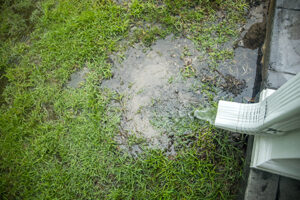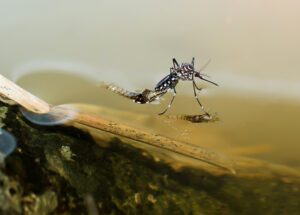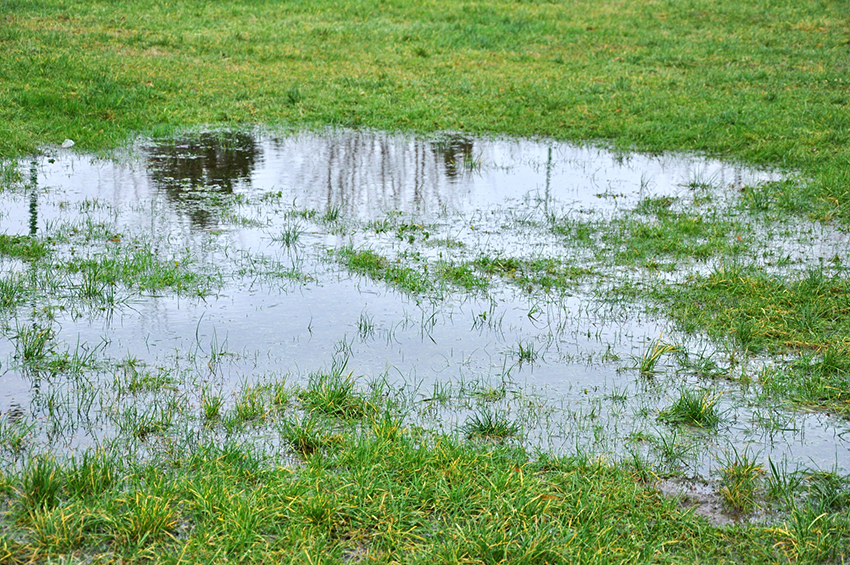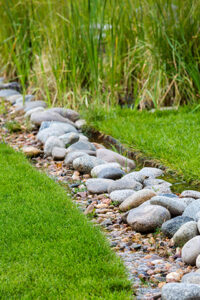While puddles can be fun for kids to play in, they are anything but when it comes to them being in your yard. Ponding water can cause serious issues. In this article we explore why drainage problems arise, and ways to solve them.
Why Are There Puddles in My Lawn?
There are several reasons why you might see puddles in your lawn long after rain has subsided. Ponding water in your yard can be caused by:
- Improper yard grading
- Over-watering and improper watering techniques
- Soil drainage issues
Grading
If your home was built recently, the builder SHOULD have taken special care to properly grade your yard to avoid standing water, particularly near your home’s foundation. Unfortunately that is not always the case. In some cases, contractors building multiple homes in a community are focused more on meeting time lines and saving money than on the long-term effects of grading. Other times, houses and neighborhoods are built on hills and slopes, making grading a difficult task. In these cases, if drainage systems were not originally installed, water can become an issue over time.
How Home Improvements Effect Grading
Even if your home was graded properly when it was built, grading can change if home improvements such as additions, pools, patios, and decks are installed. These types of installation change how your property handles water. For example, a patio that is improperly sloped can send running water toward your home rather than away, or send water to parts of your yard where pooling can happen.
 Gutters and Downspouts
Gutters and Downspouts
Standing water around your home often happens near the exit of a downspout. If your yard is not sloped away from the downspout exit, water has no choice but to pool at its base. If this is the case, it is likely a quick and easy fix. Drain extensions, while not necessarily pleasing to the eye, are inexpensive and will divert to a lower-lying area of your yard to exit. If you want a solution with more curb appeal, underground exits called dry wells can be installed. We will touch on that later in this article.
Improper Watering
A common misnomer among homeowners is that your lawn needs constant watering during summer. That’s not necessarily the case. Different grass types require different watering schedules. Turfgrass, for example, responds best to deep but infrequent watering. Even if you don’t know what type of grass you have, there are ways to know if you are watering too much, including:
- An abundance of mushrooms and/or weeds
- Yellowing grass
- Dead patches, webbing, or other oddly colored spots (a sign of fungus)
- Squishy, sponge-like spots long after you’ve watered
Generally speaking, about an inch of water per week will do your lawn well. Keep track of when it rains and how much – you might get to skip that week!
Why Be Concerned with Standing Water?
Damage to Your Home
Standing water in close proximity to your home can have a significant impact on your home’s foundation. When water pools near your home, it puts pressure on the foundation walls. When the water dries, it relieves the pressure, causing your home to shift constantly. Over time this movement can cause cracks and serious, expensive damage.
Damage to Your Lawn
Great lawns require regular care and maintenance. In order to be green and healthy, they require the right amount of water, aeration, and fertilization. One common mistake that homeowners make is over-watering. Too much water can pool and begin to cause low spots in your lawn. Low spots become larger over time, and before you know it you have a huge standing water issue. Not only that, over-watered lawns can cause fungal diseases in your grass which lead to brown and dead spots. When a fungus takes hold in your lawn, it can be difficult to combat – and fertilizing only makes it worse. For the health of your lawn it is best to water properly. To know just how much water your lawn requires, do some research on the type of grass you have. Each type requires different care and watering.
 Unsafe Environment
Unsafe Environment
Standing water in your yard causes low spots which can be dangerous to kids running and playing. The ER is filled with kids who have stepping in a hole and twisted an ankle! Aside from the physical dangers of low spots, pooling water is a breeding ground for disease-carrying bugs and mosquitoes. While you might not see them, mosquitos are most likely lurking under the surface of your puddles. Mosquito larvae mature beneath the surface of standing water before emerging and making a beeline for your family and pets. And if you’ve ever tried to rid your yard of these pesky blood suckers, you know it’s beyond difficult. It’s best not to invite them with standing water!
Solutions for Yard Drainage Issues
There are several ways of rectifying low-lying areas in your yard that are causing standing water. Some can be costly, such as re-grading your yard, and others can be low-cost, creative and even quite pretty. The solution to your unique drainage issues depends on their location and severity. Here we’ll cover a few solutions ranging in cost from lowest to highest.
Rain Gardens
Perhaps the most creative and lowest cost solution to pooling water in your yard can be a rain garden. Rain gardens are great solutions for the smaller low spots in your yard that are not close to your home. Typically, rain gardens are 4-8 inches deep, and consist of native plants that respond well to the conditions present in that location. Rain gardens are most often built at the end of a drain spout in a low-lying area.
At its base, a rain garden will have a mix of soil, sand, and compost to aid in filtration. Then, rocks and native plants are added to create a beautiful solution to your puddle!
Drainage Systems
As an alternative to completely regrading your yard, a drainage system can be installed. French drains consist of a trench filled with rocks and gravel that runs from the low-lying area to a point at which it can safely exit such as a dry well or grate. These trenches are lined with a landscape fabric to help keep soil out. These drains often exit into a dry well. Dry wells are deep holes filled with rocks that French drains and underground downspouts exit into. Water filters over the rocks, and into the soil below. Dry wells should be installed away from the home and property line, and should only be installed by a licensed professional.
Retaining Walls
If your yard has a steep slope that is causing run-off to other areas, building a tiered retaining wall and gardens can help solve your issue. Take this home for example. In the backyard shown on the right there was a steep slope that lead toward the home. This slope not much to look at aesthetically, and it was causing water to run toward the home in strong rains. Our solution was to build a tiered garden with a natural stone retaining wall, boulders, rocks, native plants, and a water feature. Now, the backyard is as beautiful to look at as it is drain-friendly functional. Retaining walls can also be used to even out sloped yards to increase outdoor living space.
Re-grading
If your home has serious drainage issues that can’t be solved with the methods above, re-grading may be your only option. Re-grading consists of completely tearing out your lawn, adding new soil which is carefully engineered to direct water away from the home properly, and re-seeding. Special considerations such as run-off into neighbors yards or other properties must be taken as not to cause others to have issues. Re-grading should only be done by a licensed professional after extensive surveys and proper installation design.
Not Sure What Solution is Best for You?
The landscape professionals at Chesapeake Landscape Group are well-versed in all types of yard drainage. We’ll evaluate your issue, look for the underlying causes, and design a solution that meets your needs and budget.



